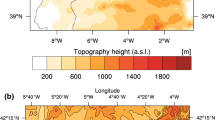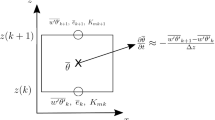Abstract
A model is presented for the height of the mixed layer and the depth of the entrainment zone under near-neutral and unstable atmospheric conditions. It is based on the zero-order mixed-layer height model of Batchvarova and Gryning (1991) and the parameterization of the entrainment zone depth proposed by Gryning and Batchvarova (1994). However, most zero-order slab type models of mixed-layer height may be applied. The use of the model requires only information on those meteorological parameters that are needed in operational applications of ordinary zero-order slab type models of mixed-layer height: friction velocity, kinematic heat flux near the ground and potential temperature gradient in the free atmosphere above the entrainment zone. When information is available on the horizontal divergence of the large-scale flow field, the model also takes into account the effect of subsidence, although this is usually neglected in operational models of mixed-layer height owing to lack of data. Model performance is tested using data from the CIRCE experiment.
Similar content being viewed by others
References
Batchvarova, E. and Gryning, S. E.: 1991, ‘Applied Model for the Growth of the Daytime Mixed Layer’,Boundary-Layer Meteorol. 56, 261–274.
Boers, R., Eloranta, E. W., and Coulter, R. L.: 1984, ‘Lidar Observations of Mixed Layer Dynamics: Test of Parameterized Entrainment Models of Mixed Layer Growth Rate’,J. Clim. Appl. Meteorol. 23, 247–266.
Boers, R. and Eloranta, E. W.: 1986, ‘Lidar Measurements of the Atmospheric Entrainment Zone and the Potential Temperature Jump Across the Top of the Mixed Layer’,Boundary-Layer Meteorol. 34, 357–375.
Carson, D. J.: 1973, ‘The Development of a Dry Inversion-Capped Convectively Unstable Layer’,Quart. J. R. Meteorol. Soc. 99, 450–467.
Carson, D. J. and Smith, F. B.: 1974, ‘Thermodynamic Model for the Development of a Convectively Unstable Boundary Layer’,Advances Geophys. 18A, Academic Press, New York, pp. 111–124.
Deardorff, J. W.: 1979, ‘Prediction of Convective Mixed Layer Entrainment for Realistic Capping Inversion Structure’,J. Atmos. Sci. 36, 424–485.
Deardorff, J. W., Willis, E., and Stockton, B. H.: 1980, ‘Laboratory Studies of the Entrainment Zone of a Convectively Mixed Layer’,J. Fluid Mech. 100, 41–64.
Driedonks, A. G. M.: 1982, ‘Models and Observations of the Growth of the Atmospheric Boundary Layer’,Boundary-Layer Meteorol. 23, 283–306.
Gryning, S. E., Holtslag, A. A. M., Irwin, J., and Sivertsen, B.: 1987, ‘Applied Dispersion Modelling Based on Meteorological Scaling Parameters’,Atmos. Environ. 21, 79–89.
Gryning, S. E. and Batchvarova, E.: 1990a, ‘Simple Model of the Daytime Boundary Layer Height’,Ninth Symposium on Turbulence and Diffusion. American Meteorological Society. April 30–May 3, 1990. Roskilde, Denmark, pp. 379–382.
Gryning, S. E. and Batchvarova, E.: 1990b, ‘Analytical Model for the Growth of the Coastal Internal Boundary Layer during Onshore Flow’,Quart. J. R. Meteorol. Soc. 116, 187–203.
Gryning, S. E. and Batchvarova, E.: 1994, ‘Parametrization of the Depth of the Entrainment Zone above the Daytime Mixed Layer’,Quart. J. R. Meteorol. Soc. 120, 47–58.
Melas, D.: 1993, ‘Similarity Methods to Derive Turbulence Quantities and Mixed Layer Depth from Sodar Measurements in the Convective Boundary Layer: A Review’,Applied Physics B 57, 11–17.
Melas, D. and Kambezidis, H. D.: 1992, ‘The Depth of the Internal Boundary Layer over an Urban Area under Sea-Breeze Conditions’,Boundary-Layer Meteorol. 61, 247–274.
Servizi Territorio: 1993,PBL-MET LIBRARY, A Software Library for Advanced Meteorological and Air Quality Data Processing, Servizi Territorio s.c.r.l., Via Garibaldi 21, 20092 Cinisello Balsamo-Milano, Italy, p. 36
Stull, R. B.: 1976, ‘The Energetics of Entrainment Across a Density Interface’,J. Atmos. Sci. 33, 1260–1267.
Stull, R. B.: 1988,An Introduction to Boundary Layer Meteorology, Kluwer Academic Publishers, p. 666
Tennekes, H.: 1973, ‘A Slab Model for the Dynamics of the Inversion above a Convective Boundary Layer’,J. Atmos. Sci. 30, 558–567.
Tennekes, H. and Driedonks, A. G. M.: 1981, ‘Basic Entrainment Equations for the Atmospheric Boundary Layer’,Boundary-Layer Meteorol. 20, 515–531.
Zeman, O. and Tennekes, H.: 1977, ‘Parameterization of the Turbulent Kinetic Energy Budget at the Top of the Daytime Boundary Layer’,J. Atmos. Sci. 34, 111–123.
Zilitinkevich, S. S.: 1975, ‘Comments on a Paper by H. Tennekes’,J. Atmos. Sci. 32, 991–992.
Author information
Authors and Affiliations
Rights and permissions
About this article
Cite this article
Batchvarova, E., Gryning, SE. An applied model for the height of the daytime mixed layer and the entrainment zone. Boundary-Layer Meteorol 71, 311–323 (1994). https://doi.org/10.1007/BF00713744
Revised:
Issue Date:
DOI: https://doi.org/10.1007/BF00713744




